iPad 4 (Late 2012) Review
by Anand Lal Shimpi on December 6, 2012 4:40 PM ESTGPU Performance
The 4th generation iPad integrates a quad-core PowerVR SGX 554 (MP4). The 554MP4 doubles USSE2 count over the previous generation PowerVR SGX 543MP4 used in the iPad 3, while keeping ROP and TMU counts the same. The result is a pure doubling of peak theoretical shader performance:
| Mobile SoC GPU Comparison | |||||||||||
| PowerVR SGX 543 | PowerVR SGX 543MP2 | PowerVR SGX 543MP3 | PowerVR SGX 543MP4 | PowerVR SGX 554 | PowerVR SGX 554MP2 | PowerVR SGX 554MP4 | |||||
| Used In | - | iPad 2/mini | iPhone 5 | iPad 3 | - | - | iPad 4 | ||||
| SIMD Name | USSE2 | USSE2 | USSE2 | USSE2 | USSE2 | USSE2 | USSE2 | ||||
| # of SIMDs | 4 | 8 | 12 | 16 | 8 | 16 | 32 | ||||
| MADs per SIMD | 4 | 4 | 4 | 4 | 4 | 4 | 4 | ||||
| Total MADs | 16 | 32 | 48 | 64 | 32 | 64 | 128 | ||||
| GFLOPS @ 300MHz | 9.6 GFLOPS | 19.2 GFLOPS | 28.8 GFLOPS | 38.4 GFLOPS | 19.2 GFLOPS | 38.4 GFLOPS | 76.8 GFLOPS | ||||
The theoretical numbers validate Apple's "2x faster GPU" claims, but as always we'll turn to Kishonti's GLBenchmark to see how achievable that performance increase is.
We'll start out with the raw theoretical numbers beginning with fill rate:
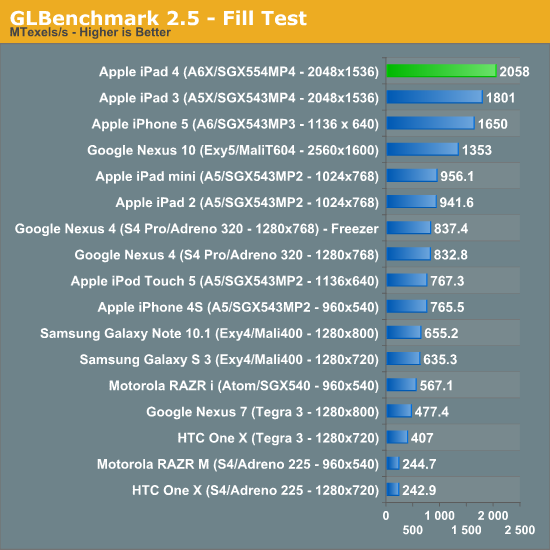
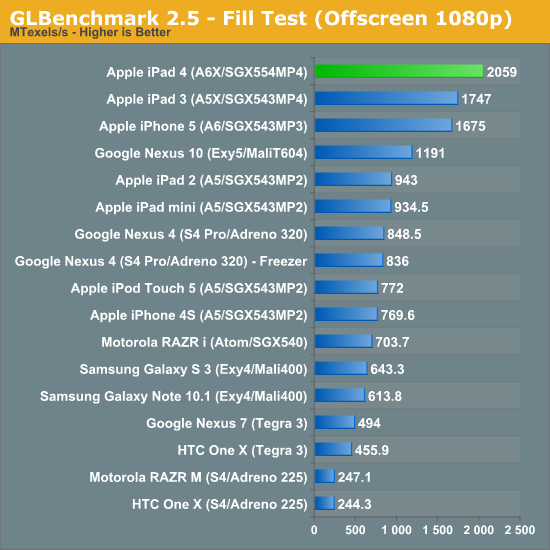
The peak fill rate test shows a ~16% increase in performance over the previous generation 543MP4. Since there's no increase in number of TMUs we're seeing the results of a higher clocked GPU in the iPad 4's A6X.
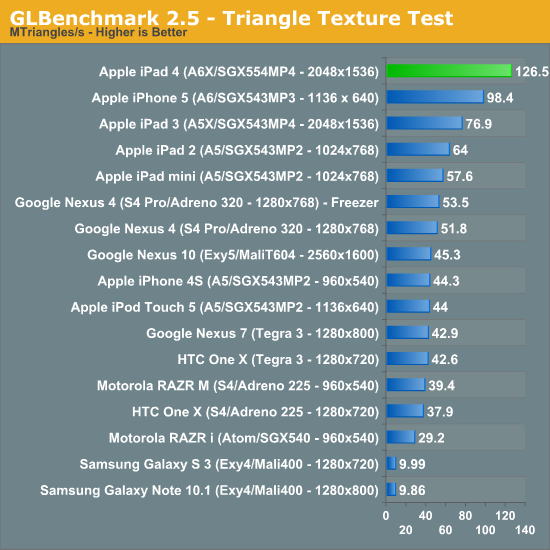
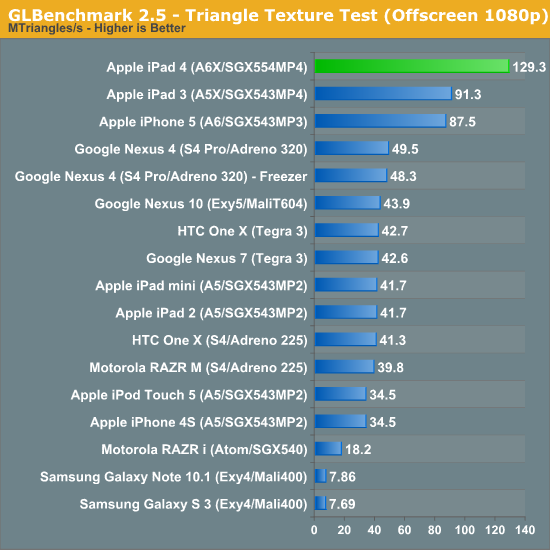
There's a pretty hefty improvement in triangle throughput - we're seeing more than a 60% gain compared to the iPad 3.
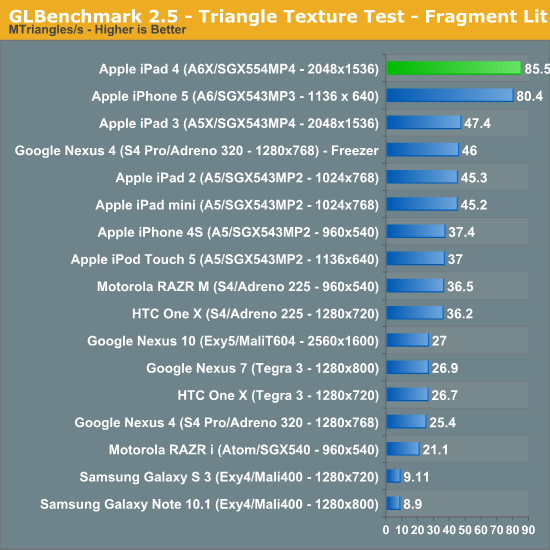
At native resolution the fragment lit triangle texture test shows a big gain over the iPad 3 (~80%).
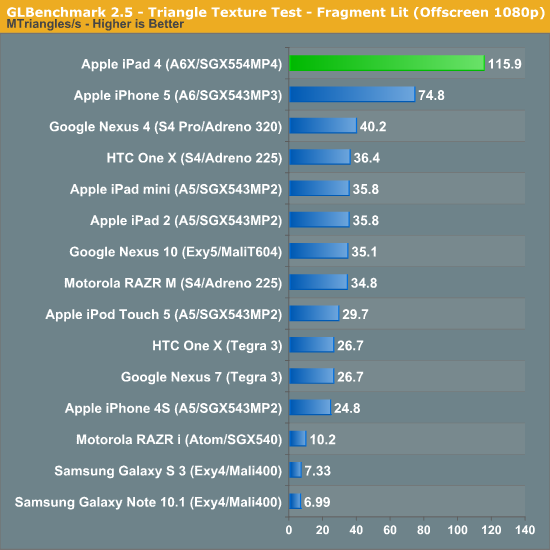
In both of the final triangle throughput tests the iPad 4 manages a 40 - 45% increase in performance over the iPad 3:
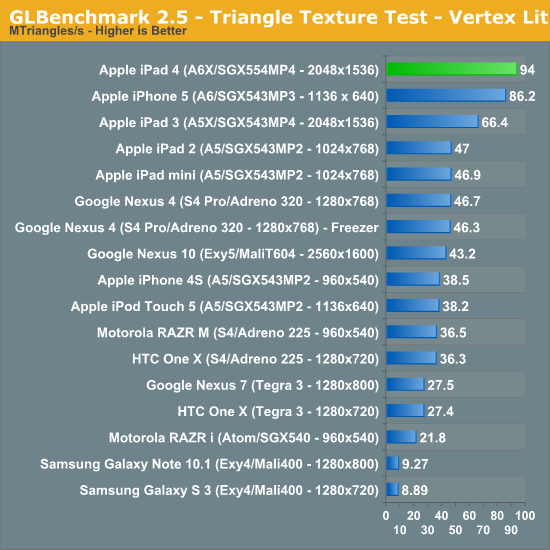

With the synthetics out of the way, we can look at simulated game performance using the Egypt HD and Egypt Classic benchmarks. Remember the on-screen tests are run at native resolution with v-sync enabled, while the offscreen tests are run at 1080p with v-sync disabled for an architectural apples-to-apples comparison.
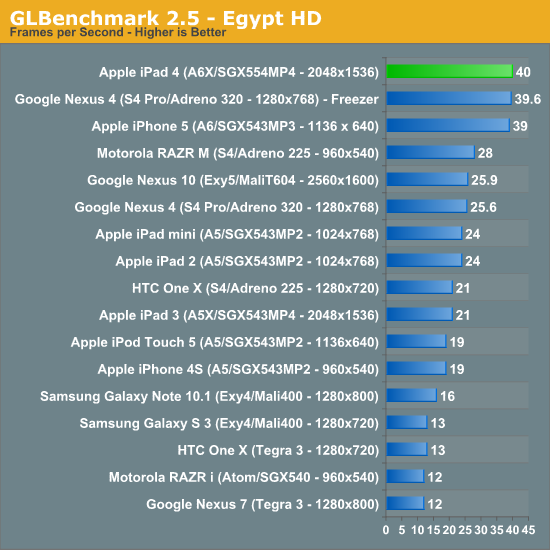
Despite sub-2x gains in a lot of the synthetic tests, Egypt HD shows us what's possible in a simulated game: the new iPad is roughly twice the speed of the previous gen model when running at the panel's native resolution. How we've seen this implemented in many cases is with titles finally running at native resolution on the iPad 4 vs. some lower, scaled resolution on the iPad 3.

The Egypt Classic test is a much lighter workload, as a result most of these devices hit 60 fps at their native resolution:
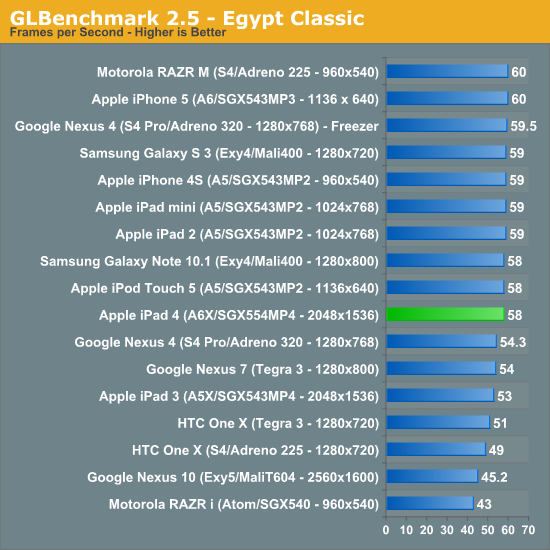
Although Egypt HD is a bit overkill for today's games, Classic undershoots by a good amount. The offscreen test however does provide some guidance as to whether or not these devices would be able to hit 30 fps on an appreciably heavier workload:
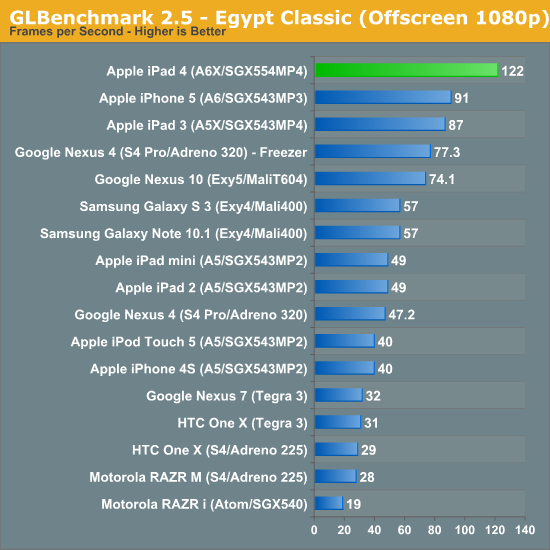










113 Comments
View All Comments
cheinonen - Thursday, December 6, 2012 - link
Color quality has always been a target, just not one that was possible for us to easily measure before. Now that we can, it's in almost every review. If that seems to favor Apple, that's only because other vendors refuse to care about it, and they aren't going to start caring until consumers understand and demand better.ltcommanderdata - Thursday, December 6, 2012 - link
It's not that pixel density is no longer important. It's that Apple has already satisfied people's needs for high pixel density. Most people already won't notice individual pixels on the iPad's 264 dpi display. So either Apple continues to improve pixel density for very little actual benefit, stops improving displays altogether, or they find another aspect of displays to improve. I think most people will be happy Apple choose the latter option and are improving color gamut and calibration.bplewis24 - Thursday, December 6, 2012 - link
I'm glad somebody else notices this. Taking a page straight out of Apple's Marketing dept.teiglin - Thursday, December 6, 2012 - link
Does Apple actually market their products this way? It's not like he's harping on it, but the S.S. Pixel Density set sail a year ago and all the high-end tablets are sufficient for most people (even the TF700, in my opinion--the steps from that to the iPad 4, then to the Nexus 10, are fairly incremental). Apple continues to differentiate its displays with proper calibration, and Anand is just pointing that out. As displays get better, it requires more attention to find the differences.The color accuracy on the Nexus 10 is objectively bad. I say this as someone who wants Google to step it up in this area--I have a Samsung tablet and my primary phone is HTC and have never owned an iPad or a Mac. Superior color accuracy isn't going to make me buy an iPad, but a dE over 8 on the Nexus 10 does make me think it's worth waiting for the generation of Google tablet.
bplewis24 - Thursday, December 6, 2012 - link
Check out their marketing materials and yes, even some of their commercials. When the coined the term "retina display" they immediately began publishing PPI measurements (and comparisons) in their marketing materials. The reason why this is significant is because other displays eventually caught up and surpassed in sheer resolution, but because the iPhone was smaller, the PPI measurement still stayed on top...even though, ironically, the benefits of such a high PPI and a much smaller display are harder to benefit from.cheinonen - Thursday, December 6, 2012 - link
The value of PPI has nothing to do with screen size, but distance relative to PPI. Just like an 84" 4K LCD has benefits if you sit 5' from it but no benefit if you are 25' from it compared to a same size 1080p display. The half-inch viewfinder of the camera I just bought has a 2.4 million dot OLED display. If that used the same PPI as a retina iPhone, with 3 dots per pixel, then that viewfinder would only have 0.2 million pixels and would certainly not be as sharp.However, as my eye is literally right next to that, a resolution way beyond 300 PPI is useful, despite the incredibly small size of the display. It's all about the distance relative to the PPI, not the size of the screen.
teiglin - Thursday, December 6, 2012 - link
I wasn't asking if they market PPI; I know that's the theme of the whole "retina" marketing. I was asking if they market the color accuracy and how their calibration is better than the competitors'. I've seem them mention the iPad's gamut (albeit briefly) but never its accuracy or calibration.EnzoFX - Thursday, December 6, 2012 - link
That's called avancement. The basis of technological progress. There Should always be something better to pursue. That is good for everyone. No matter how much your bias against Apple is.cheinonen - Thursday, December 6, 2012 - link
One more note on this. CalMAN 5 is used for measuring smartphones and tablets (and likely monitors in the future) since it supports measuring grayscale, gamut, saturations, and Gretag Macbeth charts, at any targets that we want, and with manual patterns instead of only internal pattern generators. Most solutions only allow for internal generators, which is why previous tablet and smartphone reviews (many of which were done well before Apple made a deal out of this) lack these charts as those programs don't run on an iOS or Android device.CalMAN 5 wasn't even released until September of this year, making most of these measurements impossible to do before then. So you can enjoy the conspiracy theories, but had these measurements been possible for me to do 18 months ago, I'd have done them 18 months ago.
JarredWalton - Friday, December 7, 2012 - link
On a related note, we've been discussing the importance of color accuracy on our LCD and laptop reviews for... oh, let's see... May of 2007.http://www.anandtech.com/show/2237
You'll notice that of all the laptop manufacturers, only Apple is consistently getting the display quality right (or at least, more right than others) for the MacBook Pro. And even that took a few years after my rant.